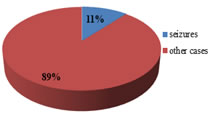|
Table of Content - Volume 17 Issue 3 - March 2021
Hospital based study of disease burden of seizure disorder in children
Madhuri B Engade1, Madhurasree R Nelanuthala2*, Baswaraj Tandoor3, Saranya Murlidharan4, Siddhi A Hembade4
1Associate Professor, 2Senior Resident, 4Junior Resident, Department of Paediatrics, MGM Medical College, Aurangabad, Maharashtra, INDIA. 3Senior Consultant, Hyderabad, Telangana, INDIA. Email: drnelamadhura@gmail.com
Abstract Background: There is a need to estimate and analyse the disease burden of seizure disorder from various Indian regions. The present study describes the proportion of seizure disorder among paediatric patients hospitalised at a tertiary care hospital in Hyderabad during the study duration. Methods: This study included children in the age group of one month to 14 years admitted at a tertiary care hospital in Hyderabad during 2014-15. All hospitalized children who presented with seizures and the children who were hospitalized for other illness and developed seizure during their stay in hospital were identified as seizure disorder patients. The total admissions of children in the same age group was obtained from the records. The proportion and age wise distribution of type of seizures was described. Results and Conclusions: Out of 3045 total paediatric admissions, 342 (11.2%) were seizure cases. Male to female ratio was 1.5:1. There were 246 admissions in the age group of 6 months – 5 years, 56 admissions in < 6months age and 40 admissions in >5years age. We conclude that significant proportion of childhood hospitalisations at the hospital are contributed by seizure disorders. Keywords: Seizures, Epilepsy.
INTRODUCTION Seizure disorders account for a significant proportion of childhood hospitalisations. There is a need for a detailed evaluation of the child with the seizure disorder, and follow up over a longer time is needed, which puts significant stress on the health infrastructure. In developing countries, optimal resource utilisation demands a proper understanding of the disease burden. There is insufficient literature available from developing countries like India regarding the disease burden of seizure disorder.1,2 There is a need to estimate and analyse the disease burden of seizure disorder from various Indian regions to better understand resource utilisation and further allocation needs. The present study describes the proportion of seizure disorder among paediatric patients hospitalised at a tertiary care hospital in Hyderabad during the study duration.
METHODS This study included children in the age group of one month to 14 years admitted at a tertiary care hospital in Hyderabad that caters mostly lower middle-class families from the region. The study duration was 2014-15. All hospitalized children who presented with seizures and the children who were hospitalized for other illness and developed seizure during their stay in hospital were identified as seizure disorder patients. Seizures were classified as per International League against Epilepsy classification system3. All eligible children whose parents refused for hospital admission were excluded. The total admissions of children in the same age group was obtained from the records. The proportion and age wise distribution of type of seizures was described.
OBSERVATIONS Out of 3045 total paediatric admissions, 342 (11.2%) were seizure cases (Figure 1). Among them, 89 (26%) were known cases of seizures. Male children were 207 (60.6%) and females were 135 (39.4%) with male to female ratio of 1.5:1. There were 246 admissions in the age group of 6 months – 5 years, 56 admissions in < 6months age and 40 admissions in >5years age. Table 1 shows age wise distribution of type of seizures. Figure 1: Prevalence of seizures
Table 1: Age wise distribution of types of seizures
DISCUSSION Among the total paediatric admissions during our study period, 11.2% were seizure cases. Male to female ratio was 1.5:1. A similar study from Nepal done over a two year period during 2014-16 among 0 to 16 year old hospitalised subjects found the proportion of seizure disorder cases to be lower at 3.4% with an almost same male: female ratio of 1.6:1 signifying the male preponderance4. However, in another study from western Nepal during 2007-11, among the age group of 6 months to 15 years, proportion of hospital admissions having seizure disorder was higher at 12.7% with similar male preponderance2. Idro R study from Kenya reported a high proportion of seizure disorder cases i.e. 18.3% among hospital admitted children aged 0 to 13 years at rural district hospital during 2004-06. Males accounted for more cases in their study5. A high male to female ratio has been reported by studies from India6-9. Few population based epidemiological research studies have been conducted in India even though the disease burden is quite high10. An epilepsy surveillance program in rural Uttarakhand state of India reported prevalence of two or more unprovoked seizures to be 7.5 per 100011. The present data is hospital based and gives an insight into the high proportion of seizure disorder cases among hospitalised children in a metropolitan city catering to lower middle class strata of society. It highlights that social awareness and support and guidance system is needed to help the families of the patients. The study limitations are hospital based study design with the sample size relatively small. Further research needs to be done to better understand the epidemiology of childhood seizure disorder so that better management strategies could be designed to effectively tackle the problem.
REFERENCES
Policy for Articles with Open Access: Authors who publish with MedPulse International Journal of Pediatrics (Print ISSN: 2579-0897) (Online ISSN: 2636-4662) agree to the following terms: Authors retain copyright and grant the journal right of first publication with the work simultaneously licensed under a Creative Commons Attribution License that allows others to share the work with an acknowledgement of the work's authorship and initial publication in this journal. Authors are permitted and encouraged to post links to their work online (e.g., in institutional repositories or on their website) prior to and during the submission process, as it can lead to productive exchanges, as well as earlier and greater citation of published work.
|
|
 Home
Home

